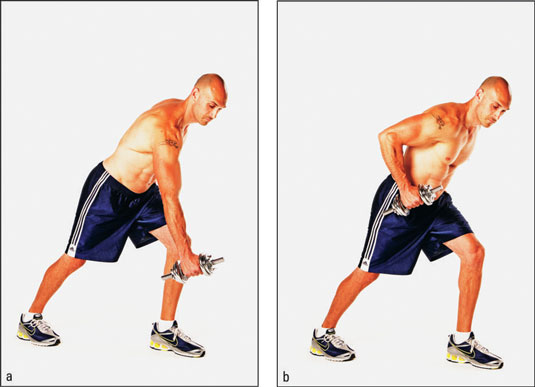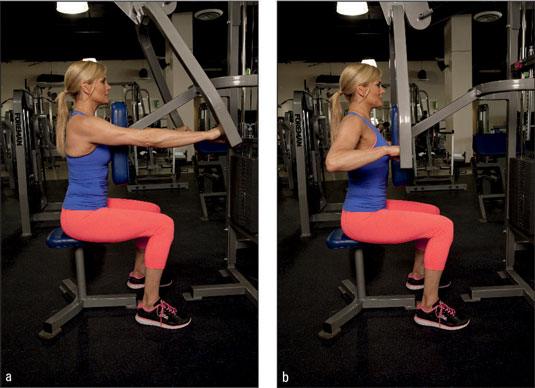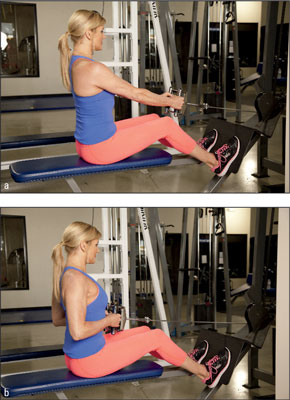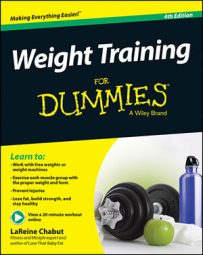Rowing exercises are similar to the motion of rowing a boat. You may perform rows with a barbell or dumbbell, a set of machine handles, a bar attached to a low cable pulley, or an exercise band. Rowing exercises use the same muscles as pull-downs and pull-ups, except that they don’t involve your chest.
Rows are particularly helpful if you want to find out how to sit up straighter — to perform a row correctly on a machine, you have to sit up tall.
One-arm dumbbell row

The one-arm dumbbell row targets your back, but also emphasizes, your biceps and shoulders.
Be careful with this exercise if you have lower-back problems.
Stand in a lunge position, left foot forward, making sure your knee doesn’t jut out past your toes. Hold a dumbbell in your right hand with your palm facing in. Let your right arm hang down underneath your right shoulder. Tilt your chin toward your chest so your neck is in line with the rest of your spine.
Pull your right arm up, keeping it in line with your shoulder and parallel to the ceiling. Lift your arm until your hand brushes against your waist. Lower the weight slowly back down.
DO remember that, although your arm is moving, this is a back exercise. Concentrate on pulling from your back muscles (right behind and below your shoulder) rather than just moving your arm up and down.
DO keep your abs pulled in tight throughout the motion.
DON’T allow your back to sag toward the floor or your shoulders to hunch up.
DON’T jerk the weight upward.
Rotation row: As you lift the dumbbell, rotate your arm so your palm ends up facing backward. This position gives the exercise a different feel and places extra emphasis on your biceps.
Barbell row: Place a barbell on the floor and stand about a foot away from it. With your knees bent, bend down and grasp the bar in an overhand grip with your hands a little wider than your shoulders. Pull your abs in tight and don’t let your back arch.
Keeping your hips bent so that your torso is at a 45-degree angle to the floor, pull the bar toward the lower part of your chest and then slowly lower it back down. You can also perform this exercise with an underhand grip or with your hands a bit closer together.
Machine row

The machine row focuses on your back, with additional emphasis on your shoulders and biceps.
Take special care performing this exercise if you’ve had lower-back or shoulder injuries.
Sit facing the weight stack of the machine with your chest against the chest pad.
Adjust the seat so your arms are level with the machine’s handles and so that you must stretch your arms fully to reach those handles. This adjustment is important — and one that many people forget to make. If you can’t fully straighten your arms when you grasp the handles, you’ll end up using your arm muscles a lot more than your back muscles.
Grasp a handle in each hand, slide your shoulders down, and sit up tall.
Pull the handles toward you until your hands are alongside your chest. As you bend your arms, your elbows should travel directly behind you, not out to the side. At the same time, squeeze your shoulder blades together. Slowly straighten your arms, feeling a stretch through your shoulder blades as you return the handles to their original position.
DO sit up even taller as you pull the weight.
DON’T lean back so far that your chest comes off the pad as you bend your arms.
DON’T round your back or lean forward as you return the handles to the starting position.
DON’T stick your neck forward as you pull the weight.
Other machines: Although each manufacturer has its own version of the machine row, the same basic rules apply. Depending on the brand, the handles may be parallel, perpendicular, or diagonal; some machines have all three grips. Experiment with different grips to get a different feel from this exercise.
Advanced machine row (harder): Do this exercise without keeping your chest on the chest pad. Without the support, you have to work harder to sit up straight.
Cable row

The cable row strengthens your back, along with your biceps and shoulders.
Be careful with the cable row if you’ve had lower-back or shoulder problems.
Sit on the machine facing the tower with your legs slightly bent and hip-width apart, and your feet firmly planted against the foot plate. Grasp the handle and straighten your arms out in front of your chest. Sit up as tall as you can, sliding your shoulders down, pulling your abdominals in and lifting your chest.
Sitting up tall, pull the handle toward the lower part of your chest, squeezing your shoulder blades together as you pull. Your elbows should travel straight back, arms brushing lightly against your sides as you go. Without stretching forward, straighten your arms slowly back to the start.
DO feel this exercise in your back, not just in your arms. Concentrate on starting the pull with the outer edges of your back.
DON’T arch or round your back.
DON’T rock back and forth to help you lift and lower the weight.
Extended row: The basic version of this exercise is excellent for targeting the upper-back muscles. However, you can strengthen your lower back at the same time by leaning forward a few inches at your hips as you stretch your arms out and by leaning back slightly as you pull the handle toward you.
Some exercise purists scorn this version because it doesn’t “isolate” your upper back, but the extended row works the upper and lower back together and is great for people who do a lot of rowing or activities like weeding, dancing, or climbing. However, skip this version if you have a history of lower-back pain.

